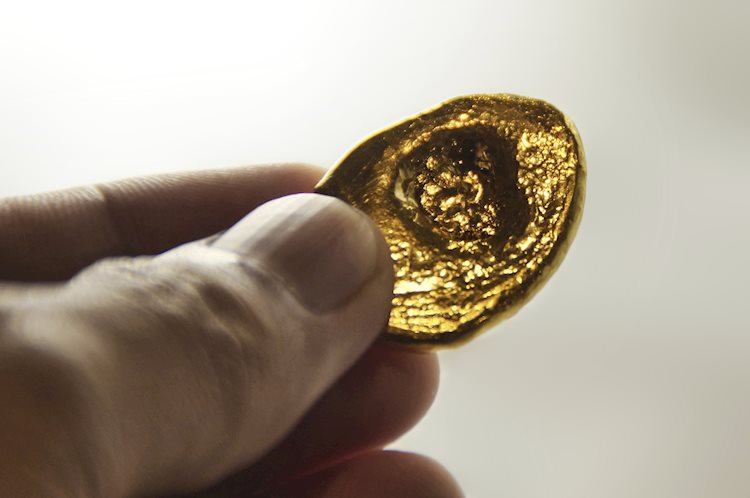Share:
Gold price catches fresh bids on Tuesday as dovish Fed expectations continue to weigh on the USD.
The upbeat market mood also does little to hinder the positive move back closer to a two-week high.
Investors now look to the crucial FOMC meeting minutes for future policy action and a fresh impetus.
Gold price (XAU/USD) builds on the overnight bounce from the $1,966-1,965 area and gains strong positive traction during the Asian session on Tuesday. The recent data from the United States (US) pointed to a slowing jobs market and easing inflationary pressures, fueling speculations that the Federal Reserve (Fed) could begin easing its monetary policy sooner than expected. This is reinforced by a further decline in the US Treasury bond yields, which drags the US Dollar (USD) to its lowest level since August 31 and lifts the non-yielding yellow metal back closer to a two-week peak touched last Friday.
The strong intraday move up, meanwhile, seems rather unaffected by a generally positive risk tone, which tends to undermine the safe-haven Gold price. China’s promise of additional government stimulus measures boosted investors’ confidence and remains supportive of the upbeat market mood, though a bearish USD continues to act as a tailwind for the precious metal. However, it remains to be seen if the XAU/USD is able to capitalize on the momentum ahead of the release of the FOMC meeting minutes, against the backdrop of the uncertainty over the timing of when the Fed will start cutting interest rates.
The US Dollar selling remains unabated in the wake of dovish Federal Reserve expectations and assisted the Gold price to regain strong positive traction on Tuesday.
Investors now seem convinced that the Fed has completed its interest rate-hiking cycle and are looking for cues on when the central bank could begin easing its monetary policy.
The rate-sensitive 2-year US government bond yield remains below the current 5.25-to-5.50% Fed funds target, suggesting that momentum in favour of rate cuts is building.
The CME’s Fedwatch tool points to a roughly 30% chance that the Fed will start cutting rates as soon as March 2024 and a nearly 100 bps of cumulative easing by the year-end.
The benchmark US 10-year Treasury yield drops to a fresh two-month low and undermines USD, offsetting the upbeat market mood and benefitting the non-yielding yellow metal.
Investors turned optimistic after Chinese officials vowed to roll out more policy support for the country’s beleaguered real estate sector and drive stronger momentum for growth.
China’s new finance minister Lan Fo’an said that the country would boost budget spending to support the post-pandemic recovery in the world’s second-largest economy.
Fed officials, meanwhile, have not ruled out the possibility that more interest rate hikes could be needed should a change in economic data require it.
Richmond Fed President Thomas Barkin said on Monday that inflation is likely to remain stubborn and force the central bank to keep rates higher for longer than investors currently anticipate.
This, in turn, could act as a headwind for the precious metal as traders look to the FOMC minutes for fresh cues about the Fed’s future policy action and some meaningful impetus.
From a technical perspective, some follow-through buying beyond last week’s swing high, around the $1,993 area, should allow the Gold price to reclaim the $2,000 psychological mark. The momentum could get extended further towards retesting a multi-month peak, around the $2,009-2,010 area touched in October. A sustained strength beyond the latter will be seen as a fresh trigger for bearish traders and set the stage for an extension of the recent goodish rebound from levels just below the 200-day Simple Moving Average (SMA).
On the flip side, the $1,978-1,977 region now seems to protect the immediate downside ahead of the overnight swing low, around the $1,965 zone. Failure to defend the said support levels could make the Gold price vulnerable to accelerate the slide back towards challenging the 200-day SMA, currently near the $1,938-1,937 zone. This is followed by the 100- and the 50-day SMAs confluence, around the $1,930-1,929 area, which if broken decisively will shift the near-term bias in favour of bearish traders and prompt some technical selling.
US Dollar price this week
The table below shows the percentage change of US Dollar (USD) against listed major currencies this week. US Dollar was the strongest against the Canadian Dollar.
USD
EUR
GBP
CAD
AUD
JPY
NZD
CHF
USD
-0.49%
-0.65%
-0.09%
-1.06%
-1.69%
-1.27%
-0.30%
EUR
0.49%
-0.16%
0.40%
-0.56%
-1.18%
-0.77%
0.19%
GBP
0.65%
0.16%
0.57%
-0.40%
-0.98%
-0.60%
0.35%
CAD
0.09%
-0.40%
-0.57%
-0.97%
-1.59%
-1.17%
-0.21%
AUD
1.04%
0.56%
0.41%
0.96%
-0.62%
-0.21%
0.75%
JPY
1.66%
1.13%
0.78%
1.52%
0.57%
0.37%
1.36%
NZD
1.25%
0.77%
0.61%
1.17%
0.20%
-0.41%
0.95%
CHF
0.31%
-0.19%
-0.35%
0.21%
-0.75%
-1.38%
-0.96%
The heat map shows percentage changes of major currencies against each other. The base currency is picked from the left column, while the quote currency is picked from the top row. For example, if you pick the Euro from the left column and move along the horizontal line to the Japanese Yen, the percentage change displayed in the box will represent EUR (base)/JPY (quote).
Gold FAQs
Why do people invest in Gold?
Gold has played a key role in human’s history as it has been widely used as a store of value and medium of exchange. Currently, apart from its shine and usage for jewelry, the precious metal is widely seen as a safe-haven asset, meaning that it is considered a good investment during turbulent times. Gold is also widely seen as a hedge against inflation and against depreciating currencies as it doesn’t rely on any specific issuer or government.
Who buys the most Gold?
Central banks are the biggest Gold holders. In their aim to support their currencies in turbulent times, central banks tend to diversify their reserves and buy Gold to improve the perceived strength of the economy and the currency. High Gold reserves can be a source of trust for a country’s solvency. Central banks added 1,136 tonnes of Gold worth around $70 billion to their reserves in 2022, according to data from the World Gold Council. This is the highest yearly purchase since records began. Central banks from emerging economies such as China, India and Turkey are quickly increasing their Gold reserves.
How is Gold correlated with other assets?
Gold has an inverse correlation with the US Dollar and US Treasuries, which are both major reserve and safe-haven assets. When the Dollar depreciates, Gold tends to rise, enabling investors and central banks to diversify their assets in turbulent times. Gold is also inversely correlated with risk assets. A rally in the stock market tends to weaken Gold price, while sell-offs in riskier markets tend to favor the precious metal.
What does the price of Gold depend on?
The price can move due to a wide range of factors. Geopolitical instability or fears of a deep recession can quickly make Gold price escalate due to its safe-haven status. As a yield-less asset, Gold tends to rise with lower interest rates, while higher cost of money usually weighs down on the yellow metal. Still, most moves depend on how the US Dollar (USD) behaves as the asset is priced in dollars (XAU/USD). A strong Dollar tends to keep the price of Gold controlled, whereas a weaker Dollar is likely to push Gold prices up.
Share:
Feed news
Information on these pages contains forward-looking statements that involve risks and uncertainties. Markets and instruments profiled on this page are for informational purposes only and should not in any way come across as a recommendation to buy or sell in these assets. You should do your own thorough research before making any investment decisions. FXStreet does not in any way guarantee that this information is free from mistakes, errors, or material misstatements. It also does not guarantee that this information is of a timely nature. Investing in Open Markets involves a great deal of risk, including the loss of all or a portion of your investment, as well as emotional distress. All risks, losses and costs associated with investing, including total loss of principal, are your responsibility. The views and opinions expressed in this article are those of the authors and do not necessarily reflect the official policy or position of FXStreet nor its advertisers. The author will not be held responsible for information that is found at the end of links posted on this page.
If not otherwise explicitly mentioned in the body of the article, at the time of writing, the author has no position in any stock mentioned in this article and no business relationship with any company mentioned. The author has not received compensation for writing this article, other than from FXStreet.
FXStreet and the author do not provide personalized recommendations. The author makes no representations as to the accuracy, completeness, or suitability of this information. FXStreet and the author will not be liable for any errors, omissions or any losses, injuries or damages arising from this information and its display or use. Errors and omissions excepted.
The author and FXStreet are not registered investment advisors and nothing in this article is intended to be investment advice.





